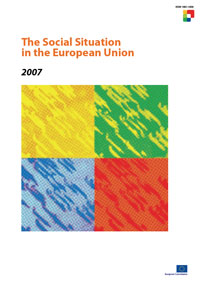 |
THE SOCIAL SITUATION
IN THE EUROPEAN UNION 2007
Eurostat, 2008, 224 pages
|
http://epp.eurostat.ec.europa.eu/cache/ITY_OFFPUB/KE-AG-08-001/EN/KE-AG-08-001-EN.PDF
Доклады о социальной ситуации в Европейском Союзе публикуются
ежегодно, начиная с 2000 года, и направлены на информирование по
вопросам социальной политики путем предоставления основных данных
и перспективного анализа. Доклад разделен на две части, первая из
которых посвящена специальной теме, которая глубоко исследуется,
а вторая, состоит из статистических портретов, охватывающих весь
спектр вопросов социальной политики, и приложения к ней.
2007 год был объявлен в Европе годом равных возможностей,
и в настоящем докладе основное внимание обращено на некоторые связанные
с этим вопросы. В частности, в нем представлены новые данные о связи
между образованием, занятием родителей и успехами их детей. Доклад
также показывает, что многие дети иммигрантов растут в семьях с
доходами ниже черты бедности.
В данном докладе также рассматривается вопрос доступа
к основным товарам, услугам и другие аспекты.
TABLE OF CONTENTS
Foreword
PART 1 — SOCIAL COHESION THROUGH EQUAL
OPPORTUNITIES
ENGLISH INTRODUCTION AND SUMMARY
1. Assessing the Case for Equal Opportunities
across the EU: An Overview
1.1. EU-SILC: The new tool for monitoring the social situation
in the EU
1.2. Income inequality and economic performance
1.3. Low incomes — a European perspective
1.4. Who are the poor: groups most at risk in the Member States
1.5. Low incomes and living standards in the EU
1.6. Intergenerational transmission of disadvantages
1.7. Children from a migration background and equal opportunities
1.8. Equal opportunities: the key to economic growth and social
cohesion
DEUTSCHE EINFÜHRUNG UND ZUSAMMENFASSUNG
1. Die Bedeutung der Chancengleichheit
in der EU: ein Überblick
1.1. EU-SILC: Das neue Instrument zur Beobachtung der sozialen
Lage in der EU
1.2. Einkommensungleichheit und Wirtschaftsleistung
1.3. Niedrige Einkommen – eine europäische Perspektive
1.4. Wer sind die Armen: die am stärksten gefährdeten
Gruppen in den Mitgliedstaaten
1.5. Niedrige Einkommen und Lebensstandards in der EU
1.6. Übertragung von Benachteiligungen zwischen Generationen
1.7. Kinder mit Migrationshintergrund und Chancengleichheit
1.8. Chancengleichheit: der Schlüssel zu Wirtschaftswachstum
und sozialem Zusammenhalt
INTRODUCTION ET RÉSUMÉ FRANÇAIS
1. Évaluation du rôle de l’égalité
des chances dans l’UE: vue d’ensemble
1.1. EU-SILC: nouvel outil pour le suivi de la situation sociale
dans l’UE
1.2. Inégalités de revenus et performances économiques
1.3. Faibles revenus – une perspective européenne
1.4. Qui sont les pauvres: les groupes les plus à risque dans
les États membres
1.5. Faibles revenus et niveaux de vie dans l’UE
1.6. Transmission intergénérationnelle des handicaps sociaux
1.7. Enfants issus de l’immigration et égalité des chances
1.8. Égalité des chances: la clé de la croissance
économique et de la cohésion sociale
MAIN REPORT
2. Income Distribution and Poverty Risks
in the EU
2.1. EU-SILC: The new tool for monitoring the social situation
in the EU
2.2. Income inequality and economic performance
2.3. Low incomes — a European perspective
2.4. Who are the poor: groups most at risk in the Member States
2.5. Low incomes and living standards in the EU
3. The Scope for More Equal Opportunities
3.1. Intergenerational transmission of disadvantages
3.2. Children from a migration background and equal opportunities
PART 2 — AREAS OF SOCIAL POLICY CONCERN:
STATISTICAL PORTRAITS
1. Economic Situation
2. Demography, Households and Families
3. Ageing of the Population
4. International Migration and Asylum
5. Education and its Outcomes
6. Lifelong Learning
7. Employment
8. Unemployment
9. Labour Market Policy Expenditure
10. Social Protection Expenditure and Receipts
11. Social Benefits
12. Income Distribution
13. Low-income Households
14. Jobless Households and Low Wages
15. Women and Men in Decision Making
16. Earnings of Women and Men
17. Life and Health Expectancies
18. Accidents and Work-related Health Problems
ANNEXES TO PART 2
Annex 1.1 Key Indicators per Geopolitical Entity — Latest Year
Available
Annex 1.2 Key Indicators per Geopolitical Entity — Time Series
Annex 1.3 Other Statistical Tables per Geopolitical Entity
Annex 2 Symbols, Country Codes and Country Groupings, other Abbreviations
and Acronyms
|

